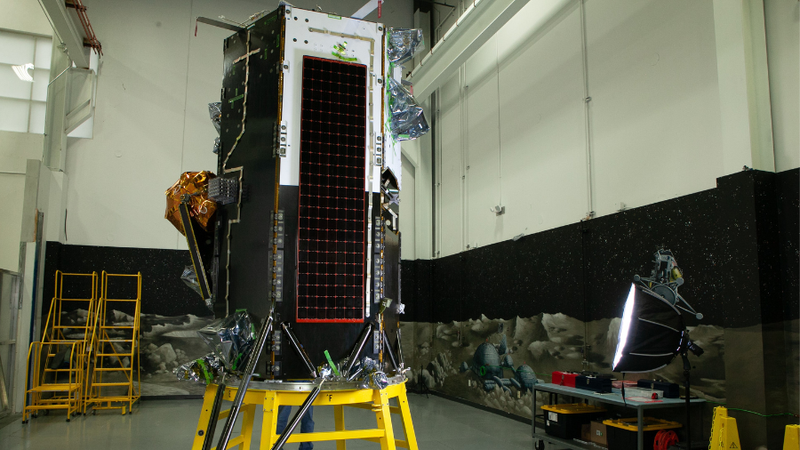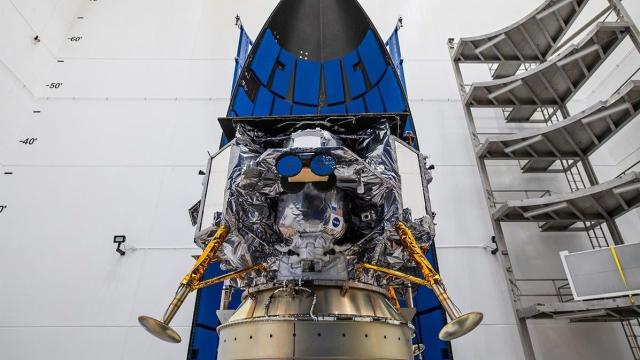Astrobotic and Intuitive Machines are all set with their Moon landers. Now they just need their rockets prepped and the launch windows to swing open. But once underway, these NASA-funded missions, slated for early 2024, will chart a new course for the future of private space exploration.
On Tuesday, Pittsburgh-based Astrobotic announced that its Peregrine lunar lander is fueled and ready to rock. The Moon mission, formally known as Astrobotic’s Peregrine Mission 1 (TO2-AB), is scheduled for launch on January 8, aboard United Launch Alliance’s Vulcan Centaur rocket, which will be performing its inaugural flight.
Originally scheduled for December 24, the mission’s launch was rescheduled due to complications encountered during the first wet dress rehearsal, leading to the need for a second rehearsal earlier in the month. The Peregrine lander is set to launch aboard the Vulcan Centaur from Cape Canaveral, Florida, pending range approval from the Space Force.
Astrobotic’s journey to the Moon is expected to take approximately 46 days, from launch to its anticipated landing on February 23. The Peregrine lander carries a range of payloads as part of NASA’s Commercial Lunar Payload Services (CLPS) program. This initiative represents a collaborative effort between NASA and U.S. companies to deliver scientific, exploratory, and technological payloads to the Moon’s surface and orbit. Importantly, CLPS is key to NASA’s Artemis program, aimed at sustainably returning humans to the lunar surface.
The mission is a first for Astrobotic—an employee-owned company—with Peregrine representing its first lunar landing attempt. The company describes the Peregrine spacecraft as a “delivery vehicle in space.” Among the 21 payloads tucked inside, two notable instruments include NASA’s Laser Retroreflector Array for precise distance measurements and its Neutron Spectrometer System, designed to detect traces of water-ice near the lunar surface. These instruments are crucial for advancing our understanding of the Moon’s geology and environment. Non-NASA payloads include BitMEX’s physical coin loaded with one Bitcoin, an Elysium Space memorial containing trace portions of human remains, and a time capsule from The Arch Mission Foundation, among others.
NASA chose a mare (a dark plain of basaltic rock formed by ancient volcanoes) near the Gruithuisen Domes as the landing site for the Peregrine mission due to its unique geological features. These domes, located at the northeastern edge of the Oceanus Procellarum, are composed of silica-rich magma, akin to Earth’s granite. This landing choice is meant to unravel a scientific puzzle, as similar formations on Earth usually involve water and plate tectonics—elements absent on the Moon, leaving the domes’ formation and development a mystery.
In related news, Intuitive Machines announced a delay in its IM-1 lunar mission, which was initially scheduled to launch on January 12. The mission will now launch no earlier than mid-February 2024. Intuitive Machines—based in Houston, Texas—is seeking to land its Nova-C lander in the Malapert A crater near the Moon’s south pole. Like Peregrine, Nova-C is a commercial vehicle, carrying various payloads for NASA as well as commercial cargo, under the space agency’s CLPS program. And like Astrobotic’s upcoming mission, this endeavor marks Intuitive Machine’s first attempt at a lunar landing.

Intuitive Machines attributed the launch delay to unfavorable weather conditions that forced SpaceX to adjust its launch schedule. In addition, the mid-February launch window is the next available opportunity due to the monthly lunar blackout period. The mission’s success relies on specific lighting conditions at the Moon’s south pole, which are only favorable for a few days each month, the company explained.
The Nova-C lunar lander is ready, having been delivered to Cape Canaveral in December. Since its arrival, the lander has completed major system tests, verifications, and certification processes. The remaining step involves integrating Nova-C into a Falcon 9 rocket fairing in preparation for the launch window.
Nova-C’s mission is to carry five NASA-sponsored instruments and additional payloads from various clients. Among these is the EagleCAM, a detachable device designed to capture Nova-C’s descent and landing on the lunar surface. The lander is expected to operate for one lunar day, approximately 14 Earth days, allowing some time for exploration and data collection.
Intuitive Machines is planning to launch three lunar missions for the upcoming year, all of which are to be launched aboard SpaceX Falcon 9 rockets. In addition to IM-1, Intuitive Machines is also planning the IM-2 mission, potentially launching in early 2024, and the IM-3 mission, which is expected to launch in mid-2024. It’s not clear if the delay of IM-1 will affect the schedule of these subsequent missions.
NASA’s partnership with private firms like Astrobotic and Intuitive Machines reflects a practical shift in space exploration, in which private landers play a crucial role. These missions offer a cost-effective way to transport payloads for both government and private entities. Excitingly, it’s an approach that combines public goals with private sector efficiency, potentially speeding up space exploration and expanding our ability to work in space.
